The Illusive Eye
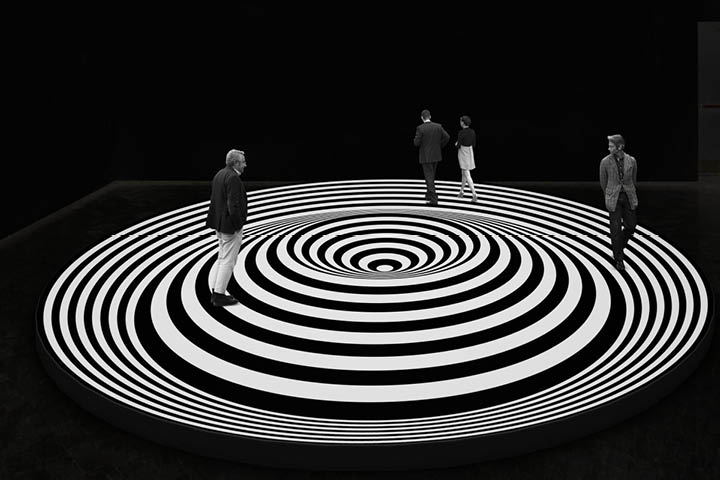
El Museo del Barrio is pleased to present The Illusive Eye, an international survey on Kinetic and Op art. The exhibition offers a broad intellectual context for Op art and geometric abstraction, one that goes against the grain of formalist art history. The selection provides a special focus on artwork from the Americas and features major artists from eighteen countries in Latin America and beyond.
“The Illusive Eye is about illusions—those we see and feel when we look at Op and kinetic art and those experienced by the curators and art historians of these movements,” said Jorge Daniel Veneciano, Executive Director, El Museo and exhibition curator. “The perceptual play of things seen and unseen provides us with a model for understanding the relative invisibility of Latin American artists in past surveys of Op art.”
The Illusive Eye puts forth a reading of Op art and geometric abstraction that is notably different from that of prior exhibitions, which focused on the psychology and physiology of perception. El Museo’s exhibition traces the concepts and values of optical art to its esoteric origins in Pythagorean (Egyptian) and Theosophical (Eastern) mysticism. The Illusive Eye places Op art in a truly international context, beyond that of the narrow European model of modernism as perpetuated by Western museums.
The Illusive Eye embarks on three objectives:
First, we revisit and celebrate the innovations of the MoMA exhibition and flesh it out with the Latin American dimension that it lacked.
Second, we put forth a notably different reading of Op and Kinetic art—offering a discursive and critical response to the traditional studies dwelling on the physiology and psychology of vision.
Third, we propose a connection between the naturalizing (responsive) theories of optical art and the naturalized absence of Latin American artists from The Responsive Eye and similar curatorial projects. The few Latin Americans represented in the MoMA show each lived in Europe at the time of the exhibition. We therefore propose a link between the lessons in the phenomenology of illusions in Op art and the parallel illusions of curatorial vision—in which focus on one object requires the invisibility of others.
Exhibition curator: Jorge Daniel Veneciano, Ph.D., Executive Director, El Museo del Barrio; author of The Geometric Unconscious: A Century of Abstraction (University of Nebraska Press, 2012).
PARTICIPATING ARTISTS
Albers, Josef | Germany; Anuskiewicz, Richard | United States; Apollonio, Marina | Italy; Bechara, Tony | Puerto Rico; Biasi Alberto | Italy; Bill, Max | Switzerland; Boto, Martha | Argentina; Briel, Ernesto | Cuba; Carreño, Mario | Cuba; Clark, Lygia | Brazil; Contreras Brunet, Iván | Chile; Costigliolo, José Pedro | Uruguay; Cruz-Diez, Carlos | Venezuela; Darié, Sandú | Cuba (born in Romania); Espinosa, Manuel | Argentina; Fangor, Wojciech | Poland; Fiaminghi, Hermelindo | Brazil; Freire, María | Uruguay; García Rossi, Horacio | Argentina; GEGO (Gertrud Goldschmidt) | Venezuela; Gómez, Norberto | Argentina; Herrera, Carmen | Cuba; Hewitt, Karen | United States; Kosice, Gyula | Argentina; Lamis, Leroy | United States; Lauand, Judith | Brazil; Le Parc, Julio | Argentina; Llorens, Antonio | Uruguay; Mac Entyre, Eduardo | Argentina; Mavignier, Almir | Brazil; Negret, Edgar | Colombia; Oiticica, Hélio | Brazil; Otero, Alejandro | Venezuela; Palatnik, Abraham | Brazil; Pape, Lygia | Brazil; Pérez, Matilde | Chile; Rayo, Omar | Colombia; Riley, Bridget | England; Rodríguez, Freddy | Dominican Republic; Sacerdote, Ana | Argentina; Sánchez, Zilia | Cuba; Sanín, Fanny | Colombia; Soldevilla, Lolo | Cuba; Sosa, Antonieta | Venezuela (born in NY); Soto, Jesús Rafael | Venezuela; Stella, Frank | United States; Tadasky (Tadasuke Kuwayama) | Japan; Tomasello, Luis | Argentina; Vardanega, Gregorio | Argentina; Vasarely, Victor | Hungary; Vidal, Miguel Ángel | Argentina; Wilding, Ludwig | Germany; and Yvaral, Jean-Pierre, France.
Generous support for this exhibition is provided by Patricia & Ramiro J. Ortíz, Lo-Mid Corporation, and Public Support from the New York City Council Speaker Melissa Mark-Viverito. Additional support has been provided by Michael J. García & Liana M. Davila, The Institute for Studies on Latin American Art (ISLAA), the Embassy of Chile, and El Museo’s Collector’s Circle.
RODRIGUEZ CALERO: Urban Martyrs and Latter Day Santos
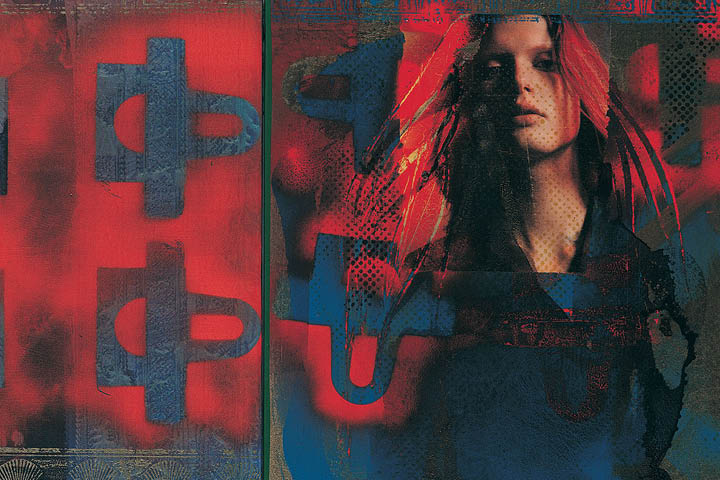
El Museo del Barrio’s “Urban Martyrs and Latter-Day Santos” is the first museum survey of the Nuyorican artist Rodríguez Calero and the second in a series of five women-artist retrospectives in El Museo’s current five-year plan.
Rodríguez Calero forges her powerful and unique style from the richly varied traditions of her own background. Born in Puerto Rico and raised mainly in New York City, she received her artistic education at San Juan’s prestigious Escuela de Artes Plásticas and the famed Art Students League of New York. After living and studying abroad, in both France and Spain, she returned to New York where she became a participating artist in the historic Taller Boricua.
Availing herself of both classical and deeply contemporary elements including surrealist collage, Catholic iconography, medieval religious painting, and hip-hop street culture, Rodríguez Calero creates vibrant and multilayered canvases that defy easy categorization. Her work offers a masterful balance of the abstract and figurative, sacred and profane, the meditative and boldly graphic. Her unerring use of dazzling color might be the first thing that attracts us to a Rodríguez Calero work, but it’s her depth of thought, complex imagery, and humane, empathetic gaze on society that draw us ever deeper in, stopping us in our tracks.
EXHIBITION OUTLINE
Rodríguez Calero’s original technique is called “acrollage,” a technique of layering glazes of luminous colors with rice and other kinds of paper. The blending of fermenting surfaces and stenciled patterns attains lustrous color and texture. Guest-curated by Alejandro Anreus, the installation includes 29 large acrollage canvases, 19 smaller collages, 13 fotacrolés (altered photography) on canvas board, and 3 works of mixed media on paper. The exhibition will be accompanied by a brochure and a scholarly catalogue.
ABOUT THE ARTIST
A member of the same generation as Juan Sánchez and Pepón Osorio, and highly regarded by her fellow artists and many curators, Rodríguez Calero has not received the attention she deserves. El Museo is proud to address this omission by mounting the first museum survey of her work. Rodríguez Calero has also received awards, honors, and fellowships from the New Jersey State Council on the Arts, Geraldine R. Dodge Foundation, and the New York Foundation for the Arts. She was awarded residencies from The New York State Council on the Arts and the National Endowment for the Arts. In 2006, she was featured in New Jersey Networks Public Television State of the Arts Series, “Sign Of The Times,” and in 2008-2009, she received the prestigious Joan Mitchell Foundation Grant in painting. She has exhibited in galleries and museums across the USA, in the Caribbean and China and her works are in many private and public collections.
CONCURRENT PROGRAMMING
As with every exhibition, El Museo will organize a series of public programs around “Urban Martyrs and Latter-Day Santos.” These programs include education activities for families and school children (art-making workshops, bilingual guided visits, storytelling), as well as program offerings for adult audiences (artist talks, panels, dance and music performances). A major concurrent event will be the summer festival, “Uptown Bounce: Summer Nights @ 104th & Fifth.” A free, three-week festival, carried out collaboratively by El Museo and the Museum of the City of New York, welcomes thousands of visitors, and hosts weekly musical performances, gallery talks, art-making workshops, and break-dancing demos.
CURATOR & ARTIST: A Conversation | To read, click here.
RODRIGUEZ CALERO: Urban Martyrs and Latter Day Santos is made possible thanks to the generous support from The Jacques and Natasha Gelman Foundation, series sponsor of El Museo del Barrio’s Women Artists Retrospective Series. With additional public support from the New York City Council Speaker Melissa Mark-Viverito.
¡PRESENTE! The Young Lords in New York
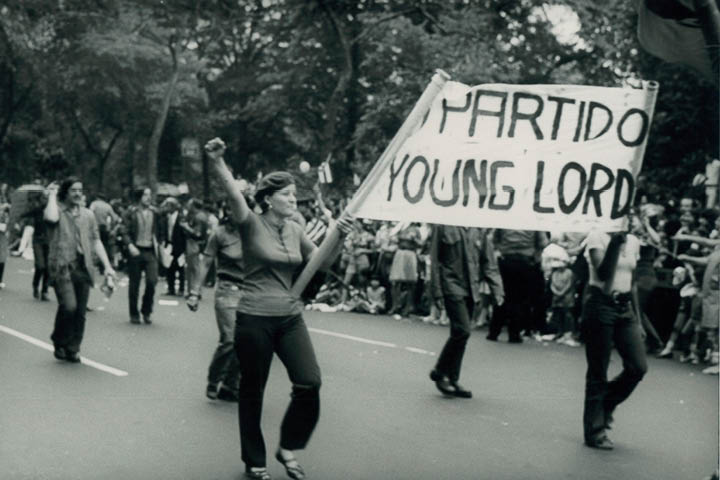
¡Presente! The Young Lords in New York explores the legacy of the Young Lords in East Harlem, the Bronx and the Lower East Side, focusing on specific political events that the Young Lords organized in these locations.
Founded in Chicago in September 1968, the Young Lords Organization later developed a chapter in New York City in July 1969 when various groups came together in the interest of neighborhood improvement and Puerto Rican self-determination. The New York chapter was led by a group of students and young people working together, including Felipe Luciano, Pablo “Yoruba” Guzman, Juan González, Juan “Fi” Ortiz, David Pérez and Miguel Melendez. Juan Gonzalez underscored the need to speak with the people of the neighborhood to begin their activist work: “We must go to them…to the masses. They may know something we don’t. So, first, we must go to the people of El Barrio.” Walking through the streets of East Harlem, the young group asked local residents about their biggest concerns in the neighborhood and the answer was nearly unanimous: garbage. The City’s Department of Sanitation rarely came to pick up garbage in East Harlem.
The Lords organized an accumulation of garbage at the center of Second and Third Avenues, near 106th, 111th, 116th and 118th Streets. Within a few days, the mayor’s special assistant came to visit El Barrio and sanitation trucks began making regular stops in East Harlem. Many more young people joined the cause and activism of the Young Lords including Luis Garden Acosta, Carlos Aponte, Connie Cruz, Jenny Figueroa, Gloria Rodriguez, Iris Morales, and Denise Oliver.
EXHIBITION OUTLINE
El Museo’s exhibition draws from works in the museum’s own collection including copies of the Young Lords weekly newspaper, Palante. It also explores the legacy of the Young Lords and the relationship between art and activism. Images by photographer Hiram Maristany that feature the Young Lords’ Garbage Offensive, their take over of the First Spanish Methodist Church of East Harlem (later renamed by the Young Lords as The People’s Church), their free morning breakfast program, the rerouting of a TB-testing truck and the funeral of Julio Roldán will all be highlighted in the exhibition.
Paintings and political prints (Antonio Martorell, Domingo García, and Marcos Dimas) from El Museo’s permanent collection will be on display. Works commissioned specifically for this exhibition by Coco Lopez, JC lenochan, Miguel Luciano, and Shellyne Rodriguez are also featured.
¡Presente! The Young Lords in New York will be exhibited at The Bronx Museum of the Arts (July 2 – October 15, 2015), El Museo del Barrio (July 22-December 12, 2015), and Loisaida Inc. (July 30 – October 10, 2015). The exhibition is co-organized by all three institutions.
At El Museo del Barrio the exhibition is made possible with Public Support from Speaker Melissa Mark-Viverito and the New York City Council.
CUT N’ MIX: Contemporary Collage
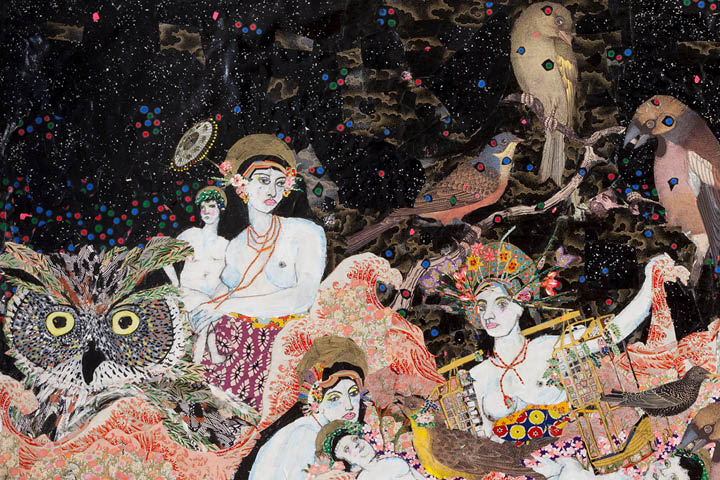
This exhibition explores the work of artists experimenting with collage and collage techniques in ways that expand the gestures of cutting paper and mixing various mediums together. It takes as its point of departure some of the concepts from Dick Hebdidge’s series of essays collectively titled Cut N Mix: Culture, Identity and Caribbean Music, published in 1980. In this text, Hebdidge explored the variations of Caribbean reggae and dancehall and other related styles of music as emblematic markers of Caribbean ideas of nationhood, belonging, and the making of culture.
Hebdidge notes the following about additional versions of a song, a kind of sound collage that is made from the original melody: On the dub, the original tune is still recognizably there, but it is broken up. The rhythm might be slowed down slightly, a few snatches of song might be thrown in and then distorted with echo. (p. 83)
This idea of an original form of working (the paper collage) that has been changed in some way through more radical processes is addressed in various ways in this exhibition. So-called traditional collages are included, in which papers or photographs or prints or magazine images are placed over other layers of paper. In addition, more “extreme” versions of collage are featured, such as layered and burnt linoleum, overlaid cardboard and fabric, gigantic collaged works, and pop-style drawings collaged into digital videos.
The artists included in the exhibition range from established artists who are veterans of collage to new generations of artists experimenting with this malleable medium.
PARTICIPATING ARTISTS
Elia Alba, Jesse Amado, Blanka Amezkua, Javier Barrera, Maria Berrio, Cecilia Biagini, Michael Paul Britto, José Camacho, Karlos Carcamo, Nat Castañeda, Gaby Collins-Fernandez, Matias Cuevas, Rafael Ferrer, Roger Gaitan, Carolina Gomez, Javier Ramirez/NADIE, Carlos Gutierrez Solana, Hector Madera, Glendalys Medina, Alex Nuñez, Catalina Parra, Carlos Rigau, Hernan Rivera Luque, Linda Vallejo, Rafael Vega and Eduardo Velázquez.
UNDER THE MEXICAN SKY: Gabriel Figueroa—Art and Film
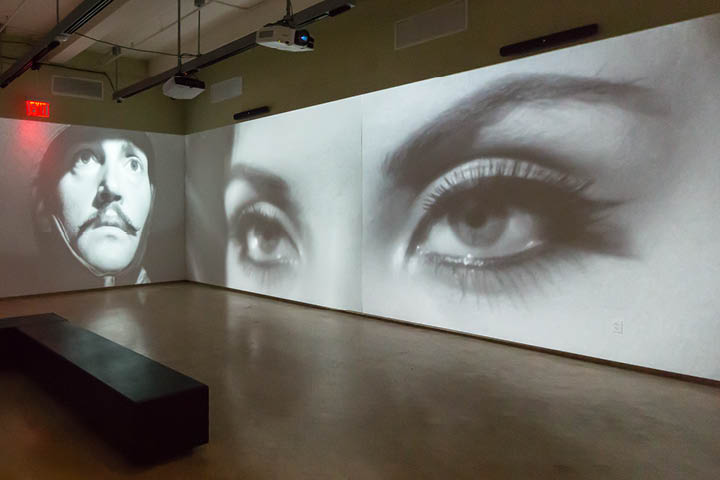
From the early 1930s through the early 1980s, the Mexican cinematographer Gabriel Figueroa (1907–1997) helped forge an evocative and enduring image of Mexico. Among the most important cinematographers of the Golden Age of Mexican Cinema, Figueroa worked with leading directors from Mexico, the United States and Europe, traversing a wide range of genres while maintaining his distinctive and vivid visual style.
In the 1930s, Figueroa was part of a vibrant community of artists in many media, including Diego Rivera, Jose Clemente Orozco, Edward Weston and Manuel Alvarez Bravo, who sought to convey the country’s transformation following the trauma of the Mexican Revolution. Later, he adapted his approach to the very different sensibilities of directors Luis Buñuel and John Huston, among others. Figueroa spoke of creating una imágen mexicana, a Mexican image. His films are an essential part of the network of appropriations, exchanges and reinterpretations that formed Mexican visual identity and visual culture in the mid-twentieth century and beyond.
The exhibition features film clips, paintings by Diego Rivera, Jose Clemente Orozco, Manuel Rodriguez Lozano and José Chavez Morado, photographs, prints, posters and documents, many of which are drawn from Figueroa’s archive, the Televisa Foundation collection, the collections of the Museo de la Estampa and the Museo Nacional in Mexico. In addition, the exhibition includes work by other artists and filmmakers from the period such as Luis Buñuel, Sergei Eisenstein, Edward Weston, and Tina Modotti that draw from the vast inventory of distinctly Mexican imagery associated with Figueroa’s cinematography or were heavily influenced by his vision.
UNDER THE MEXICAN SKY: Gabriel Figueroa—Art and Film is a project by Televisa Foundation and CONACULTA. Corporate Benefactor is Metlife Foundation. Exhibition Benefactor is Tony Bechara. Public support from Speaker Melissa Mark-Viverito and the New York City Council. Additional support provided by the Circulo de Coleccionistas of El Museo del Barrio, the Mexico Tourism Board, the Mexican Cultural Institute of New York, and the Mex-Am Cultural Foundation, Inc.
PLAYING WITH FIRE: Political Interventions, Dissident Acts, and Mischievous Actions
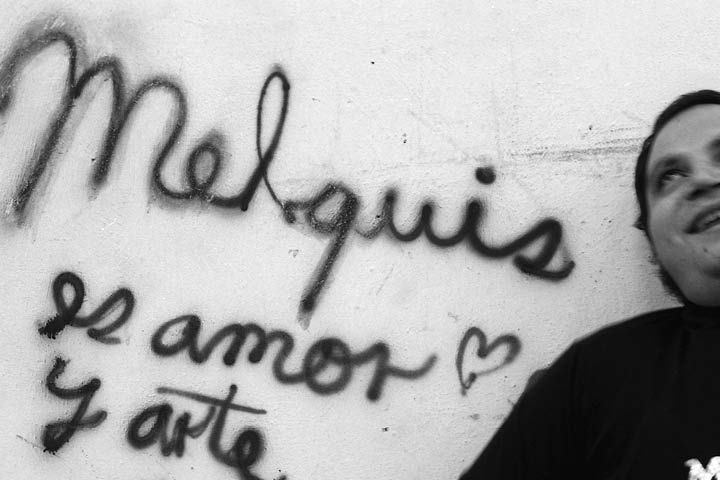
Tracing the founding of El Museo del Barrio by Raphael Montañez Ortíz at the end of the 60s, an era of social unrest and radical activism in the United States as well as throughout the Americas, the works in this exhibition target colonialism, imperialism, urban neglect, and cultural hegemony with a vast array of weapons, including irreverence and humor. The artists confront the status quo with a wide range of disarming conceptual strategies and aesthetic detonators. The fire that surfaces in some of the artworks points to an equally dangerous and alluring element that consumes and transforms, one that must be handled with care.
Playing with Fire: Political Interventions, Dissident Acts, and Mischievous Actions purposely welcomes impolite, undomesticated, rebellious, hilarious, and even sacrilegious discourses and gestures that stick out their tongues at oppressive systems and push for the re-politicization of society and the art space.
PARTICIPATING ARTIST
ADAL, Manuel Acevedo, Maris Bustamante, Nao Bustamante, Papo Colo, Abigail DeVille, Alejandro Diaz, Adonis Flores, Ester Hernández, Javier Hinojosa (b. 1956, México, D.F.) with the collaboration of Melquiades Herrera (Mexico, D.F., 1949-2003), Jessica Kairé, Carlos Jesus Martinez Dominguez, Ricardo Miranda Zúñiga, Carlos Ortíz, Pedro Pietri, Jesús Natalio Puras Penzo (APECO), Quintín Rivera Toro, Juan Sánchez.
The exhibition, as part of El Museo’s Carmen Ana Unanue gallery is guest curated by multi-disciplinary artist Nicolás Dumit Estévez.
CROSSFIRE: Artist Interviews
Nicolás Dumit Estévez asked artists in Playing with Fire to interview each other as well as to engage with him in Q and A’s dealing with their specific contributions to the exhibition or with their art practice in general. These exchanges aim to spark conversations, debates, and to plant a seed for potential collaborations between the participants. During the last seven years, Estévez has received mentorship in art and everyday life from Linda Mary Montano, a leading figure in the performance art field and a pioneer of the Q and A format within the arts. For example, seePerformance Artists Talking in the Eighties published by University of California Press. Crossfire was conceived and edited by Nicolás Dumit Estévez.
Read interviews here.
MARISOL: Sculptures and Works on Paper
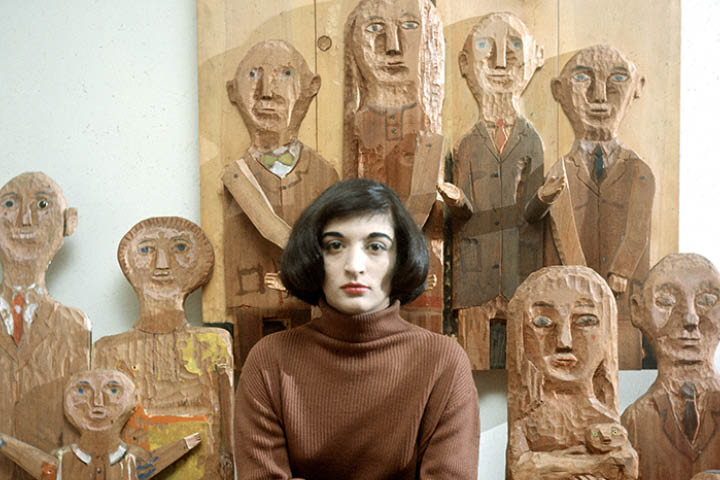
The exhibition represents the artist’s first solo show in a New York museum, features 30 works by the artist, and is the first retrospective to include Marisol’s work on paper in conjunction with her sculptures. The exhibition reestablishes Marisol as a major figure in postwar American art, fosters a broader understanding of her work, and positions it within a larger historical context. The various phases of Marisol’s career are explored, beginning with her early carvings, cast metal works, terracottas, large, complex sculptures, and a broad selection of works on paper.
Marisol is best known for her large figural sculptures, which address a variety of subjects pivotally important in the second half of the twentieth century, including women’s social roles, new family dynamics, as well as historical and contemporary figures. Her sculptures, an amalgam of several artistic styles and references, are composed of drawn and painted elements; plaster casts, carved wood and stone, assembled plywood; industrial materials such as neon, Astroturf, and mirrors; and many found objects including clothing, televisions, and baby carriages.
Among the themes explored in the exhibition are Marisol’s many influences (Neo-Dada, Surrealism, American and Latin American folk art, Pre- Columbian art, etc.); her relationship to postwar art and cultural movements (Pop, Minimalism, and Feminism); her experimentation with materials; her extensive use of portraiture; her politically charged sculptures; and her identity as a female artist from an eclectic background.
The exhibition is accompanied by a catalogue, co-published between the Memphis Brooks Museum of Art and Yale University Press. It will be sold at El Museo’s gift shop, La Tienda.
The exhibition is organized by the Memphis Brooks Museum of Art, Memphis, Tennessee. Curated by Marina Pacini.
MARISOL: Sculptures and Works on Paper received lead support from The Jacques and Natasha Gelman Foundation. Support provided by the Circulo de Coleccionistas at El Museo del Barrio: Tony Bechara, Nina Fuentes, and Anonymous. National sponsors include the Andy Warhol Foundation for the Visual Arts, ArtWorks, the National Endowment for the Arts, FedEx, and the Henry Luce Foundation. Additional support provided by Audi, and the Venezuelan American Endowment for the Arts.
MAXIMILIANO SIÑANI I BEETLES
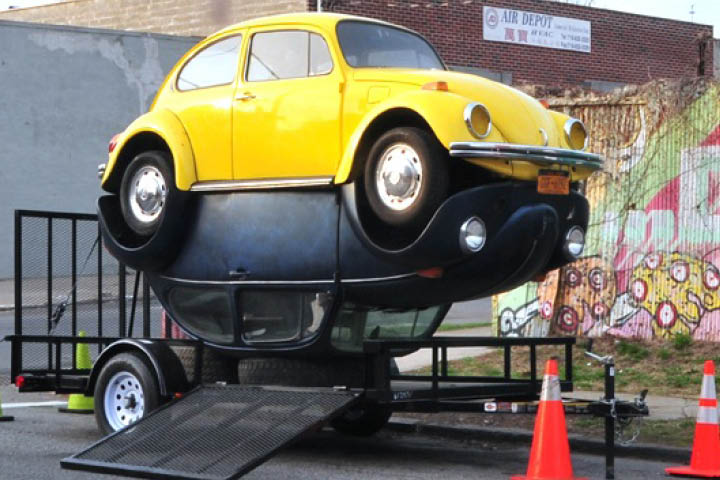
Beetles is a sculpture made of two 1972 & 1974 Volkswagen Beetles connected by their four wheels. Maximiliano Siñani (b. La Paz, Bolivia, 1989) uses these vehicles to transform them into a static sculptural object posing the question what if two cars can stand in for two people in a moment of intimacy?
The Volkswagen or People’s Car surely was one of most extraordinary success stories in the history of the automobile. The Beetle began life as a pet project of Adolf Hitler, who commissioned engineer Ferdinand Porsche to design a low-cost vehicle for the German people. Production eventually began post-World War II, under the British army then occupying much of Germany. Its manufacture lasted in Germany until 1978-or 1980 for the cabriolet-but continued in Latin America, latterly in Mexico (known as Vocho), until 2003. In all, over 21 million Beetles were made, an all-time record for a single model. Beetles provides a new line of sight on the perceptive signifier of the automobile, the vehicles connected together by its four wheels that cannot go forward but must, instead, stay in the same place.
El Museo presents the artist’s first solo show in a New York museum.
MUSEUM STARTER KIT: Open with Care

“The cultural disenfranchisement I experience as a Puerto Rican has prompted me to seek a practical alternative to the orthodox museum, which fails to meet my needs for an authentic ethnic experience. To afford me and others the opportunity to establish living connections with my own culture, I founded El Museo del Barrio.” -Raphael Montañez Ortiz
This exhibition explores the significance of the creation of El Museo by focusing on works of art made by Raphael Montañez Ortiz, as the artist turns 80 this year. Among the works on display by our founder will be his powerful Archaeological Find #21: The Aftermath (1961), a destroyed sofa as a sculpture from 1961 that is a signature of the artist’s work. Also prominent in this gallery will be his Maya Zemí I and Maya Zemí II, pyramid-shaped cardboard sculptures that illustrate his profound interest in connecting the historic indigenous cultures of the Caribbean and Mesoamerica.
To create a contemporary parallel to Montanez Ortiz’s open and generous vision, El Museo has invited a group of local artists from East Harlem to in turn invite the people of East Harlem to bring objects from their homes for display in the museum’s galleries. This reversal of expected museum exhibition practice underscores the museum’s commitment to creating connections with its audiences but also its interest in interrogating the role of the museum, the potential of the object and the human impulse to collect.
Historic figures who have been included in past exhibitions such as the conceptual and performance artist Papo Colo and photographer and filmmaker Perla de Leon will be highlighted. A handful of work by artists who have never been highlighted at El Museo before will round out the exhibition, including a group of drawings by Zilia Sanchez, found object sculptures by Romy Scheroder, and a space where visitors and tour groups will take a seat created by the Brooklyn based collective, BroLab. One gallery will feature their hand-made benches from recycled plastic, where audiences will be invited to sit and contemplate the invention of their own museum and to fantasize about which works of art and architecture they would include.
Hear from the curator of our new exhibition, Museum Starter Kit: Open with Care! Rocío Aranda-Alvarado shares how the exhibition came together, what surprised her about the show, and reflects on the legacy of Raphael Montañez Ortiz.
El Museo has partnered with a group of local artists and neighbors from El Barrio (East Harlem) to invite community members to bring objects from their homes for display in the museum’s galleries. These displays will grow and change over time, creating ephemeral museums of the moment. This portion of the exhibition celebrates the human impulse to collect and will be organized in collaboration with an Artists/Neighbors Curatorial Committee. Members include: Jaime Davidovich, Alexis Duque, Christopher Lopez, Lina Puerta, Judith Escalona/ medianoche gallery, Debbie Quiñones, and Manny Vega.
Artist in this exhibition, include Beverly Acha, BroLab, Papo Colo, Perla de Leon, Tamara Kostianovsky, LNY, Mata Ruda, Geraldo Mercado, Raphael Montañez Ortiz, Zilia Sánchez, Neighbor/Artists Curatorial Committee of East Harlem, Romy Scheroder, Luís Stephenberg. For bios on our participating artists, click here.
PRESENCIA: Works from El Museo’s Permanent Collection
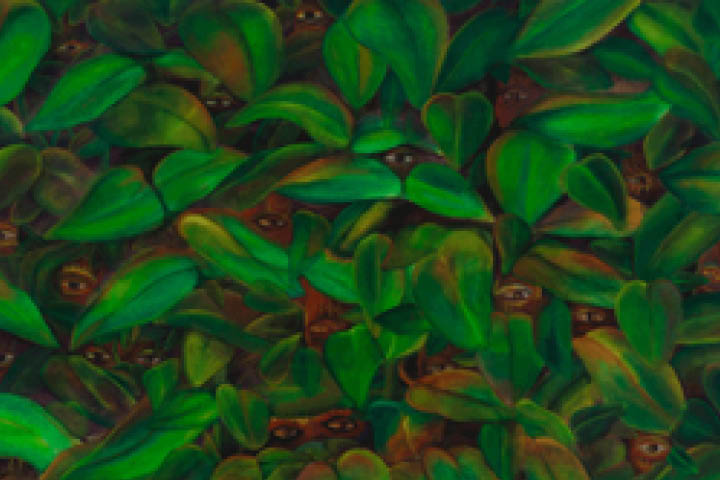
PRESENCIA, the most recent exhibition of work from El Museo’s permanent collection, focuses on ideas of presence and its antithesis, absence. This theme is explored through photography, painting, prints, drawings, masks, and other objects. The exhibition investigates the visibility and invisibility of the human form through the presentation of the body in literal and conceptual ways. The featured artists play with their figures, showing bodies revealed and obscured, evidently displayed or camouflaged.
Featured artists include Luis Mendez, whose figurine sculptures and masks evoke both the ancient and modern stylistically harkening back to the artistic tradition of ancient cultures, yet rendered with the modernist attention to form and space; Shaun El C. Leonardo, a multi-discipline artist who embodies the traditional masculine and heroic figure of the Lucha Libre wrestler to explore the myths they perpetuate; and Oscar Muñoz, whose innovative use of carbon powder renders his self-portraits unstable, oscillating between existence and nothingness. Others on view include Benvenuto Chavajay, Christian Cravo, Roberto Juárez, Fernando Salicrup, and Rafael Tufiño.